Gasoline and diesel spills can happen in an instant but can cause a lifetime of damage if not dealt with appropriately. In a rush, this leaves many car owners wondering how to get the gasoline smell out of a car.
Thankfully, the answer is simple: you remove the gasoline stain. In this article, TheCarXpert will show you how to remove a gasoline or diesel stain permanently using only cleaners found around your home.
1. Understand How To Work With Gasoline Or Diesel Safely
Although we rely on gasoline to fuel our cars, trucks, and boats, gasoline and diesel can both be harmful to human health. According to the National Fire protection service:
- There are 150,000 fires nationwide as a result of gasoline.
- Flammable liquid fires (including gasoline) cause $1.5 billion in property damage annually
- One gallon of gas is as explosive as 20 sticks of dynamite.
- Nearly 500 Americans die annually in gasoline-related fires.
To keep yourself and your family safe, it is essential to understand the properties of fuel and the signs of harmful exposure before working with a gasoline spill.
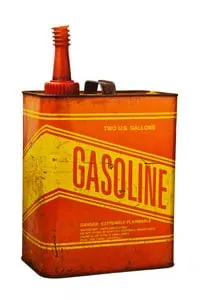
The Properties Of Gasoline & Diesel
According to the Centre for Disease Control (CDC) gasoline is a refined petroleum product consisting of hydrocarbons, additives, and blending agents. Gasoline is produced in oil refineries from crude oil.
While Americans typically think of ‘gasoline’ high-octane, tetraethyllead (TEL) gasoline was phased out in the 1970s. Today, Americans use low-sulfur gasoline-filled with antiknock compounds. In 2018, Americans used 393 million gallons of automobile gasoline every day.
The word ‘gasoline’ applies to several types of gas, including autogas (LPG) and fuels containing butanol, methanol, ethanol, or gasohol. Like gasoline, diesel is also a refined petroleum product. Diesel comes in several forms, including synthetic diesel, biodiesel, and DME (Dimethyl ether).
Here are some quick properties of today’s gasoline and diesel:
- Automobile gasoline and diesel reach its boiling point between 85° F and 390° F. This depends on your climate.
- Automobile gasoline and diesel are not pure petroleum distillate, as both fuels contain additives. This includes detergents for cleaning, anti-icing agents to prevent stalling, and antioxidants to reduce “gum” formation.
- Gasoline and diesel are liquids but releases vapors at any temperature.
- Diesel is less flammable than gasoline, but neither substance should ever come into contact with a naked flame.
It’s also important to understand that gasoline and diesel fires cannot be extinguished with water, as both substances have a low density and are hydrophobic. That means that when water comes in contact with fuel, it does this.
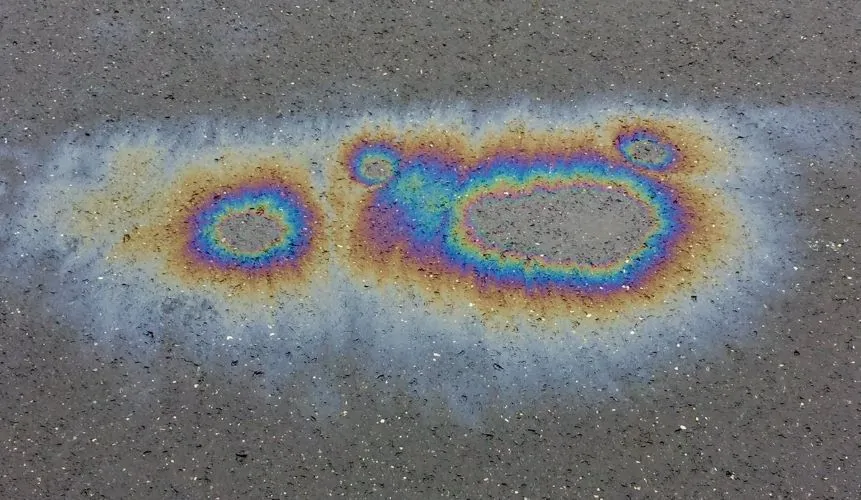
Gasoline also contains at least 15 chemicals that are hazardous to human health, including:
- Benzene
- Toluene
- Naphthalene
- Trimethylbenzene
- Methyl tert-butyl ether (MTBE)
Gasoline is also a known carcinogenic, according to the National Institute for Occupational Safety and Health. Petroleum-derived diesel contains 75% saturated hydrocarbons and 25% aromatic hydrocarbons – including naphthalenes and alkylbenzenes.
Storing Gasoline Safety
While gasoline and diesel are both perfectly safe in your car’s fuel tank, many people occasionally need to store fuel separately. If you need to store fuel, please follow these precautions from the American Petroleum Institute.
- Check with your local and state governments for regulations of gasoline storage specific to your area.
- You must store no more than 25 gallons in containers of 5 gallons or less each.
- Only store fuel in an approved container. Use a red container for gasoline, a yellow container for diesel, and a blue container for kerosene.
- Keep fuel containers closed and outside of your home (like in a garage or shed).
- Handle fuel outdoors and in well-ventilated areas.
- Store fuel at room temperature, away from the sun and heaters. Store fuel 50 feet away from ignition sources and do not smoke nearby.
- Do not mix gasoline, kerosene and diesel under any circumstances.
- Dispose of all cleaning materials in labeled containers. Contact your local waste disposal centre for region-specific disposal guidelines.
Suspected Gasoline Leaks
If you suspect the spill you are cleaning up is the result of a gas leak in your fuel system ensure you:
- Consult a mechanic as soon as possible.
- Avoid using the vehicle until the leak is fixed.
- Do not expose your car to any form of flame, as gasoline and diesel are highly flammable.
- Keep your vehicle as far away from children and pets as your property allows.
Driving with a gasoline or diesel leak is dangerous as it may cause yourself and others to become exposed to fuel vapors. Depending on the severity of the leak, the spill may constitute a serious fire hazard.
WARNING
Gasoline and diesel vapors do not always carry a smell. You can still inhale harmful amounts of gasoline without smelling anything.
2. Prepare Appropriate PPE
Before you can begin cleaning gasoline or diesel out of your car, it is essential to gather personal protective equipment (PPE) that will keep you safe. While most Americans don’t have hazard-suits at home, the Occupational Safety and Health Administration (OSHA) recommends those working with gasoline or diesel wear:
- Eye protection
- Skin protection
- Respiratory Protection
When cleaning up a spill (even a minor one) or trying to get rid of the gas smells in your car, proper protective equipment is essential.
Eye Protection

Although many American’s don’t realize it, vapors from gasoline can cause long term damage to your eyes. To keep your eyes safe from exposure, we recommend any of the following forms of eye protection:
- Safety glasses
- Chemical safety goggles
- Face shields
- Wide-brimmed glasses
Skin Protection
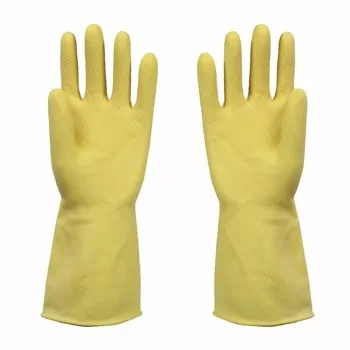
Gas smells are caused by the presence of gasoline vapors. Even in small amounts, these can cause burns, rashes, and skin irritation. To avoid this, we recommend wearing:
- Rubber or plastic gloves
- Closed-toe shoes
- Cotton or cotton-polyester blend clothing that covers the majority of your body
Respiratory Protection

You can reduce your exposure to gasoline vapors by using respiration protection. We recommend wearing any of the following:
- Surgical masks
- N-95 respirators
- Full-face respirators
- Half-mask respirators
- Homemade masks at least 3 layers of fabric thick
At the very least, ensure your nose and mouth is covered while working with gasoline.
Before beginning the cleaning process, we also recommend gathering a fire extinguisher or fire blanket if possible.
3. Stop The Spill And Block Off The Area
If you are treating a large gasoline spill, stop the source of the spill as quickly as you can. If you have spilled gasoline in a container, move the container to a shaded area while you clean.
Then, remove everything you can from your vehicle. This includes children’s car seats and floor mats. If you have spilled gasoline on these, clean them separately. Ensure children and all adults without proper PPE stay at least 15 feet away from the gasoline spill.
Next, prevent the gasoline from spreading by laying down a barrier around the spill. This barrier can be made with anything non-flammable and disable, including rags or an absorbent material like cat litter, soil, or sawdust.
Ventilate the area around the spill to the best of your ability. This includes opening all car doors and windows. Once you’ve done this, you’re ready to learn how to get the gasoline smell out of your car.
4. Soak Up Excess Gasoline
The most effective way to get rid of gas smells in your car is to remove any trace of gasoline from the interior of your vehicle. For this, you’ll need to clean up the gasoline as best you can.
Then, we recommend soaking up excess gasoline with absorbent material. For this, we have two suggestions.
Cat Litter, Sawdust, Or Potting Soil
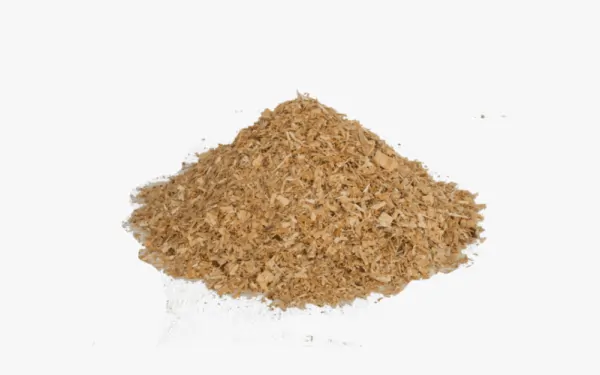
When soaking up gasoline in a rush, you may not have time to travel to your nearest hardware store. Instead, we recommend using an absorbing agent already present in your home, including cat litter, sawdust, flour, sand, or potting soil.
These materials are designed to be extremely absorbent while masking odors. Although they aren’t perfect, these agents are safe to use with gasoline. For this technique, you will need:
- An absorbent agent (cat litter, sawdust, sand, flour, potting soil, etc.).
- A brush and shovel.
- Rubbish disposal bags.
- A broom.
First, spread your absorbent agent over the entire area of the spill. Leave the spill for 5 – 10 minutes to allow it to absorb the gasoline. Then, use the brush, shovel, and broom to scoop up the absorbing agent and dispose of it in your disposal bags. Ensure you remove at least 95% of the absorbent agent before proceeding to step 5.
Rags
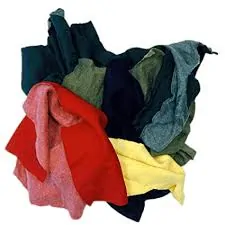
Most American homes have plenty of rags on hand (even if they don’t know it). Any fabric you are happy to throw away can become a rag. For this technique, you simply need any of the following:
- Old towels.
- Old clothing.
- Old linen
- Newspapers, paper towels, or recycled paper.
- Rubbish disposal bag.
- A pair of scissors.
To clean up the spill, cut these rags into large pieces of fabric and place over the gasoline spill. Wearing gloves, remove soaked rags from the spill and place in your rubbish disposal bag. You will need to keep replacing the rags until the rags stop absorbing gasoline.
To prevent your disposal bags from spontaneously combusting, keep gasoline-soaked materials in a ventilated and shaded area. Contact your local hazardous waste disposal centre for correct disposal procedures.
Once you have soaked up at least 95% of the spilled gasoline, you are ready to neutralize the gasoline odor.
5. Neutralize The Gasoline Odor
Once you have removed at least 95% of the spilled gasoline, it is time to neutralize the gasoline odor while removing the remainder of the spill. For this, you will need a basic cleaning agent. Here are three cleaning agents we recommend:
- Baking soda.
- White vinegar.
- Cornflour.
As gasoline is hydrophobic, we do not recommend using pure hot water to clean a gasoline spill. This will simply distribute the gasoline further while masking the smell. Instead, here are three easy techniques to get rid of gas smells in your car.
Baking Soda
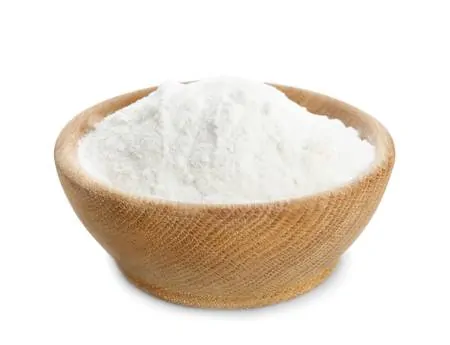
Baking soda (bicarbonate soda) dates back to 3500BCE in Ancient Egypt, where it was used as a cleaning agent. Today, baking soda is a kitchen staple in every American home.
Baking soda is a type of salt that has a basic pH. As the odors in gasoline are acidic, baking soda will absorb gasoline and neutralize its smell. Baking soda is also coarse and abrasive, which makes it excellent at cleaning stains from carpet or fabric in cars.
When cleaning a gasoline spill, we recommend applying baking soda in these stages:
- Apply a healthy coating of baking soda over the spill.
- Leave the baking soda for 30 minutes to one hour.
- Use your brush and shovel to scoop up the baking soda and dispose of it in a separate container.
- Mix 2 tablespoons of baking soda with ¼ of a cup of water until the mixture forms a thick paste.
- Apply the thick paste over the surface of the spill.
- Leave the paste for 15 minutes before collecting the mixture and disposing of it.
- Repeat these steps if desired.
White Vinegar
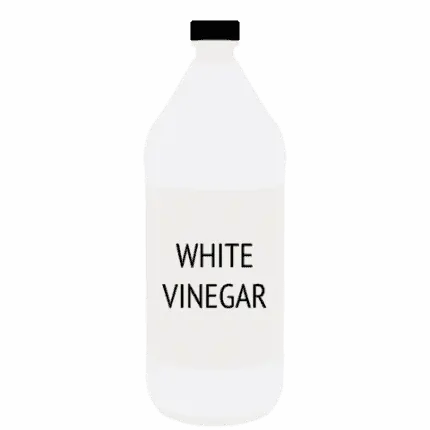
White vinegar is generally formed with 5 – 10% acetic acid and 90 – 95% water. This makes white vinegar incredibly acidic, which is why it’s so effective in cleaning smelly gasoline stains.
While white vinegar is very effective, it may damage the dye in your car’s upholstery – so use with care.
When cleaning a gasoline spill, we recommend applying vinegar in the following stages:
- Mix 1 of a cup of vinegar with 1/2 of a cup of water.
- Pour or spray white vinegar mixture over the surface of the gasoline spill.
- Leave the mixture for 15 – 20 minutes.
- Use clean rags to dry up the mixture.
- Apply flour to soak up excess liquid.
- Remove flour.
- Repeat steps if required.
Cornflour
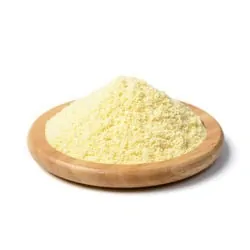
Like baking soda, cornflour is an incredibly basic cleaning agent. Cornflour absorbs acidic odors very quickly and can simply be removed by adding a small amount of water and scrubbing.
If you have a fireplace, you may also want to swap the cornflour for soot. Soot has been used as a cleaning agent since medieval times, but must not come into contact with human skin. Soot can be removed with a small amount of vinegar.
To use cornflour to clean up a gasoline stain, follow these steps:
- Spread a thick layer of cornflour over the surface of the stain.
- Leave the cornflour on the stain for 15 – 20 minutes.
- Sprinkle drops of water over the cornflour to create a gentle paste. A spray bottle will work best for this.
- Leave this paste for a further 10 minutes.
- Clean the paste with clean rags or newspaper and dispose of rags.
- Repeat steps if desired.
We do not recommend vacuuming cornflour or soot up unless you plan on disposing of the vacuum, as the vacuum will retain traces of gasoline.
Once you are satisfied with your progress, you are ready to move on to the next step.
6. Allow The Gasoline To Evaporate
Gasoline and diesel both contain water, which needs to evaporate before you can treat and scrub the stain out of your car. After you have removed 95% of the spill from your vehicle, we recommend you:
- Park the car in a sunny area away from pets, children, and the street.
- Open every door and window in the vehicle to its full capacity.
- Leave the vehicle for 4 – 6 hours to allow the excess gasoline and diesel to evaporate.
If the majority of the spill or gasoline smell comes from upholstery that can be removed from the vehicle, place the upholstery on the ground to allow it to dry separately.
The best time to air-dry your vehicle is between the hours of 10 am and 4 pm, as these are the hottest times of the day with the highest Ultraviolet Light (UV) rating.
Once the area of the spill is dry to the touch, you are ready to treat the spill.
7. Deep Treat And Scrub
Once the majority of the stain and smell has disappeared, it’s time to treat the remainder of the smell with a powerful cleaning agent. While it might be tempting to jump straight into a fabric cleanser back at step 4, you must remove the gasoline from your car – as gasoline spills are hazardous to human health when left unattended.
When treating areas affected by gasoline and diesel spills, you need to use a cleaning agent that will counter the smell of gasoline while removing the greasy particles left in your vehicle.
For this, we have three suggestions. For the best results, try the coffee ground technique after the other cleaners.
Carpet, Fabric, Or Upholstery Cleaner.
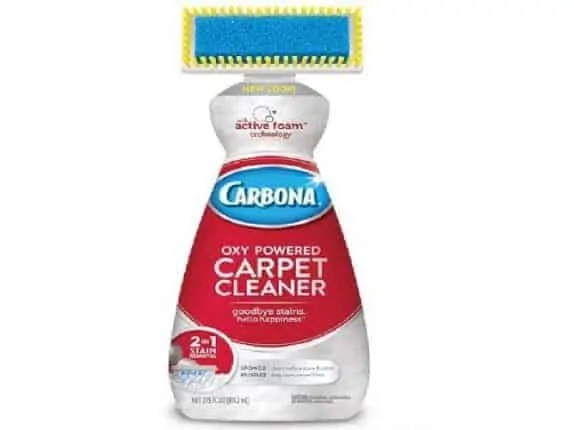
Fabric cleaners are great for deep cleaning greasy stains, but you don’t need an automobile-specific cleanser. To remove a greasy stain like gasoline or diesel, you need a cleanser with ingredients in the following four categories:
- Alkaline builders.
- These are very acidic ingredients that remove greasy contaminants. Popular alkaline builders include Sodium carbonate (soda ash), Sodium bicarbonate (baking soda), borax, sodium metasilicate, and phosphates like disodium phosphate and trisodium.
- Solvents.
- Solvents are ingredients that dissolve the greasy parts of stain that are water-soluble. Popular solvents include butyl cellosolve, butyl carbitol, citrus, d-limonene, propylene glycol, and m-pyrol.
- Emulsifiers.
- Emulsifiers remove stains that do not react to alkaline builders as they allow oil and water ingredients to mix. Emulsifiers are essential for motor oil or gasoline stains. Popular emulsifiers include cetearyl alcohol, cetearyl glucoside, and sorbitan olivate.
- Surfactants.
- Surfactants are compounds that lower the surface tension between liquids, gases, and solids. Popular surfactants include ethoxylated alcohol, sodium lauryl sulfate (SLS), Linear Alkyl Benzene Sulfonate (LAS), and sodium laureth sulfate.
All of these ingredients will be found in a carpet, fabric, or upholstery cleaner.
To apply these cleaners properly, apply the following steps.
- Collect several cups of water in a bucket with a rag. The water should be as hot as you can tolerate.
- Wearing your PPE, apply the cleansers onto the surface of the stain and scrub.
- Every 10 – 15 seconds, rinse the rag in your budget of hot water. Change the water when necessary.
- Repeat the scrubbing process at least five times, working a circular scrub over the entire surface of the stain.
- Leave the stain with the cleaner for at least 30 minutes.
- When you are satisfied with your progress, use a fresh container of water to rinse the surface of the stain.
- Leave the stain in the sun to dry until all water has evaporated.
Laundry Powder
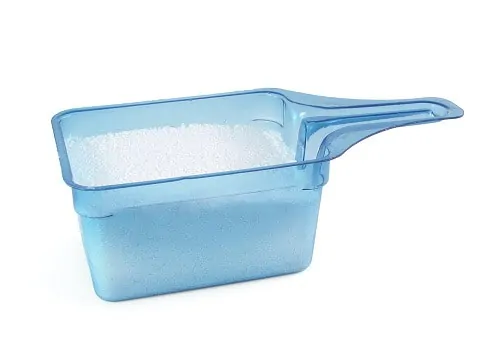
If you are looking for a cleaning agent that is a little stronger or you don’t have a carpet cleaner on hand, laundry power is a great option. Most conventional laundry powers will contain alkaline builders, surfactants, solvents, and emulsifiers – making them perfect for deep cleaning stains.
To use laundry powder to get the gasoline smell out of a car, follow these steps.
- Gather several rags and two buckets. Fill one with water.
- Mix water and laundry powder in the second bucket. To work at a greasy stain, we recommend one ‘lid’ of laundry power (generally 1 tablespoon) to two cups of water. For best results, use water as hot as your hands can tolerate.
- Wearing gloves, use a rag to work this mixture into the stain. Scrub in circular motions for 10 – 15 seconds at a time then rinse the rag in a separate bucket.
- Repeat this process at least five times or when you are satisfied.
- Use clean water to rinse the laundry powder out of the stain and leave the stain in the sun to dry until all water has evaporated.
Please ensure you wear gloves during this process as heavily-concentrated laundry powder can cause a rash in some people.
Coffee Grounds
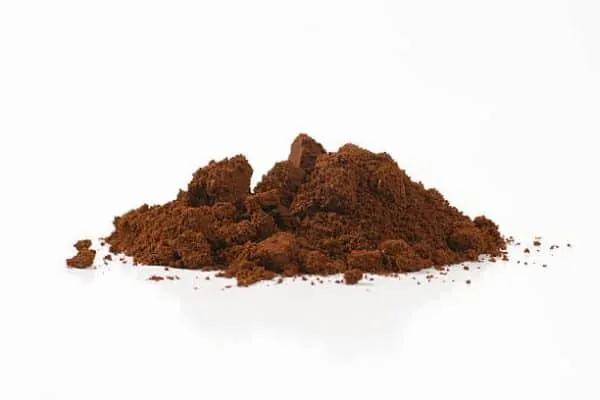
Coffee grounds may seem like a strange choice to get the gasoline smell out of a car, but there’s a method to this madness. Coffee grounds are a powerful scrub as they have both antibacterial and antiviral properties. Their strong smell masks powerful odors.
Coffee grounds are also very coarse, making them effective at cleaning carpets or greasy stains. Of course, coffee grounds will leave behind a slight stain but this is easily removed with some vinegar and water.
Here’s how we recommend using coffee grounds.
- Collect damp coffee grounds in a container. Collect water in a separate container with rags.
- Use a wet rag to work the damp coffee grounds into the surface of the stain. Scrub in circular motions and rinse your rag every 10 – 15 seconds.
- Repeat this process at least five times.
- Leave the coffee grounds in the stain for at least 25 minutes.
- Use a clean rag and a small amount of white vinegar to rinse the coffee grounds out of the stain and leave it in the sun to dry.
As coffee grounds have a very strong smell, you may want to work them into a stain to mask any lingering gasoline smells.
8. Assess If Further Help Is Needed
After you have gone through the process of soaking up the excess gasoline, neutralising the odor and deep treating the stain, you will be left with one of two situations. You may have completely removed the smell and the stain.
However, some stains are so serious professional help is needed. You may need professional help if:
- The gasoline smell remains in your vehicle.
- The stain is still smelly after deep cleaning.
- Your car is unusable because of the gasoline smell and stain.
- You believe the gasoline has damaged your vehicle.
Even though the stain may constitute an emergency, you have every right to obtain a quote from multiple places before settling on a vendor. Contact your automotive insurance company for additional help.
Remember, at a certain point, it may also be cheaper for you to replace parts of your car like seat covers and car seats.
9. Dispose Of Materials Safely
Once you have completed the cleaning process, you must dispose of all materials safely. Any object coated in gasoline or diesel must be bagged and taken to your nearest hazardous waste disposal centre as soon as possible.
If you must keep these items overnight, ensure they are outside your residence and are not exposed to direct sunlight, naked flamed, or any amount of heat.
We do not recommend washing clothing that is coated in gasoline in your washing machine, as it may cause serious damage to your machine. Instead, soak in laundry powder overnight and dry before washing. If you cannot wash these clothes safely seek the help of a dry cleaner.
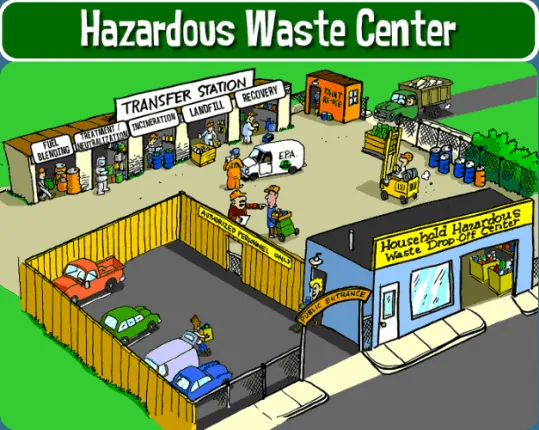
Frequently asked questions (FAQ)
Will The Gasoline Smell Go Away?
The gasoline smell in your vehicle will go away if you take proper precautions to clean the stain the smell is emanating from. This includes soaking up the gasoline, neutralizing the smell, and deep cleaning the gasoline stain.
How To Neutralize Gasoline Odor?
Gasoline odor can be neutralized with a cleaning agent that draws out gasoline. Suggested cleaning agents include baking soda, white vinegar, and cornflour. Gasoline can only be neutralized once 95% of the stain has been soaked up.
How To Soak Up Gasoline Safely?
Gasoline can be soaked up safely using non-flammable materials that are absorbed. This includes cat litter, flour, soil, sand, rags, paper towels, and sawdust. Coat the stain in these materials and remove them with a broom. Dispose of all materials immediately.
Is It Safe To Wash Clothes With Gasoline On Them?
Clothing that is wet with gasoline cannot be washed in a washing machine, as the gasoline may damage the machine. Instead, soak these clothes in a bucket with laundry powder and dry before washing. If the stain is serious, seek the help of a dry cleaner.
How To Get The Gasoline Smell Out Of A Car?
The most effective way to remove the gasoline smell from a car is to remove the gasoline stain causing the smell. The most effective way to do this is through soaking up the spill, neutralizing the odor, and deep cleaning the affected area. After 24 hours of air-drying, the smell should fully dissipate.
How To Remove Gasoline Smell From Hands?
You can remove the smell of gasoline from your hands by washing your hands with hot water and a hand cleanser. The best hand cleaners to use include lemon juice, hand soap, dishwashing detergent, and vanilla extract and water. Scrub hands for at least 20 seconds.
Is It Bad To Smell Gasoline Fumes?
Directly inhaling gasoline fumes can cause carbon monoxide poisoning, which can cause lung damage and death. To prevent exposure, wear safety glasses, gloves, and respiratory protection when working with gasoline.
Final Tip
Working out how to get the gasoline smell out of a car can be tricky. To keep you going, here are our best three tips.
- Keep your personal protective equipment on at all times to prevent you from getting carbon monoxide poisoning.
- Keep the area around your vehicle well ventilated with portable air conditioners. Do not work in a confined space or garage.
- Use coffee grounds as a final treatment for gasoline smell, but seek professional help if the gasoline smell does not dissipate after 48 hours.
If you’d like some additional tips to keep your car clean and happy, check out our guide to removing spilled paint inside cars here.

Garry is the happy owner of a funky 2018 Nissan Juke Ti-S AWD. After growing up around his family’s mechanics shop, he is passionate about bringing budget-friendly car care to every driver. Garry has a business degree and is a car enthusiast.

